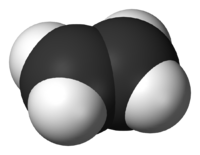
Photo from wikipedia
The objective of this study is to explore the impact of the molecular structure on the rate and product distribution during olefin pyrolysis. Particular focus is on characterizing the reaction… Click to show full abstract
The objective of this study is to explore the impact of the molecular structure on the rate and product distribution during olefin pyrolysis. Particular focus is on characterizing the reaction pathways, leading to the formation of molecular weight growth species. Propene, the smallest olefin that can form allylic radicals, and the three butene isomers were selected as model olefins. The experimental data were taken from several earlier studies that were conducted in a tubular flow reactor at an absolute pressure of ∼0.82 atm over a temperature range of 535–810 °C with a residence time of ∼2.4 s. The variations among the four olefins in terms of the observed conversions, generation of light products, and formation of molecular weight growth species were compared to the predictions of a fundamentally based detailed kinetic model with generally very satisfactory results. It was found that addition reactions of resonantly stabilized radicals to unsaturated products that can form unusually stable adducts, espe...
Journal Title: Energy & Fuels
Year Published: 2017
Link to full text (if available)
Share on Social Media: Sign Up to like & get
recommendations!